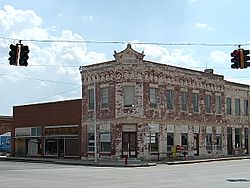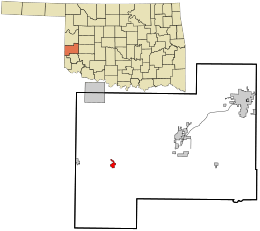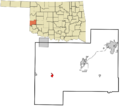Erick, Oklahoma facts for kids
Quick facts for kids
Erick, Oklahoma
|
|
|---|---|

Corner of Sheb Wooley and Roger Miller streets in Erick
|
|

Location in Beckham County and the state of Oklahoma
|
|
| Country | United States |
| State | Oklahoma |
| County | Beckham |
| Area | |
| • Total | 0.94 sq mi (2.45 km2) |
| • Land | 0.94 sq mi (2.45 km2) |
| • Water | 0.00 sq mi (0.00 km2) |
| Elevation | 2,064 ft (629 m) |
| Population
(2020)
|
|
| • Total | 1,000 |
| • Density | 1,059.32/sq mi (408.88/km2) |
| Time zone | UTC-6 (Central (CST)) |
| • Summer (DST) | UTC-5 (CDT) |
| ZIP code |
73645
|
| Area code(s) | 580 |
| FIPS code | 40-24200 |
| GNIS feature ID | 2410451 |
Erick (pronounced EER-ik) is a small city in Beckham County, Oklahoma, United States. It is about 15 miles (24 km) west of Sayre, which is the county seat. Erick is also just 6 miles (10 km) east of the border between Oklahoma and Texas. In 2020, about 1,000 people lived there.
The area where Erick is now got its first post office on November 8, 1900. It was first called Dennis. The community grew along a railroad line built in 1902. On November 16, 1901, the town's name was changed to honor Beeks Erick. He was a developer who helped plan the town. Erick officially became a city that same year.
Contents
History of Erick
Erick started in 1901 as a farming community. It was located near what would become the edge of the Dust Bowl during the Great Depression in the 1930s. The town was on the National Old Trails Road, which later became part of U.S. Route 66.
When Oklahoma became a state in 1907, Erick had 686 people. In 1908, Erick tried to become the county seat but lost to Sayre by a small number of votes. By 1909, Erick was a busy place. It had many stores, cotton gins, blacksmiths, and even two banks and two newspapers. The population grew to 915 by 1910 and reached its highest point of 2,231 in 1930. This growth was due to a short oil boom. The city's economy also got a boost from cotton gins and an ice plant. However, by 1940, the population had dropped to 1,591.
The city did well for a short time between World War I and World War II. This was when natural gas was found nearby. The book The Grapes of Wrath, published in 1939, was not popular in Erick. Many local people felt it gave a bad name to people from Oklahoma and nearby states.
Erick and Historic Route 66
In the 1940s, places for travelers to stay, like motor courts, started to appear. The DeLuxe Courts was one of the first places on Route 66 in Erick to be listed in travel guides. After World War II, Erick became a popular stop on Route 66. Many businesses opened to serve people driving on the highway. Guidebooks described Erick as a town with a "western" look, with wide streets and horsemen.
The last part of Route 66 in Oklahoma to be replaced by Interstate 40 was the section from Sayre to Erick. This happened in 1975. Today, many of the original Route 66 businesses are gone or used for other things.
Cal Rogers, a World War II veteran, opened Cal's Country Cooking on Route 66 in 1946. He moved his restaurant to an I-40 exit in 1979 when the new highway took traffic away from the old road. The family sold the business in 1999.
The West Winds Motel, which once had cool neon signs of bucking broncos, is still standing. It is no longer open, but people have tried to fix it up.
Since the late 1980s, people have been working to make "Historic Route 66" a tourist attraction again. Many local businesses now welcome tourists who want to see what's left of the old road.
The old City Meat Market building is now the Sandhills Curiosity Shop. This shop was visited by the creators of the 2006 animated movie Cars. The shop's owners, Harley and Annabelle Russell, were even models for the voice of the character Mater in the film.
The Roger Miller Museum opened in 2004. It was in a building that used to be a café and drugstore. The museum closed in 2017. Now, the 100th Meridian Museum is in that space.
Famous Country Musicians
Erick was home to two well-known country music stars. Sheb Wooley, who was an actor, songwriter, and singer, was born in Erick in 1921. He was famous for his song about the "one-eyed one-horned flying purple people eater." Roger Miller, another country superstar, was born in Texas but grew up in Erick from age three. He wrote famous songs like "King of the Road" and "Dang Me." Herbert Mayfield, from the Mayfield Brothers, was also born in Erick.
Geography and Location
Erick covers about 1 square mile (2.45 square kilometers) of land. It is located just south of I-40. The historic US Route 66 also runs through the town. Erick is the second closest Oklahoma town to the Texas border on US 66 or I-40. Only Texola, about seven miles (11 km) to the west, is closer. Erick is also served by State Highway 30. It is still a railroad town, serving as an end point for Farmrail.
Climate
| Climate data for Erick, Oklahoma | |||||||||||||
|---|---|---|---|---|---|---|---|---|---|---|---|---|---|
| Month | Jan | Feb | Mar | Apr | May | Jun | Jul | Aug | Sep | Oct | Nov | Dec | Year |
| Mean daily maximum °F (°C) | 50.7 (10.4) |
55.8 (13.2) |
65.1 (18.4) |
74.9 (23.8) |
82.2 (27.9) |
89.9 (32.2) |
95.6 (35.3) |
94.0 (34.4) |
86.0 (30.0) |
76.1 (24.5) |
62.4 (16.9) |
52.3 (11.3) |
73.8 (23.2) |
| Mean daily minimum °F (°C) | 22.5 (−5.3) |
27.1 (−2.7) |
35.3 (1.8) |
45.4 (7.4) |
54.4 (12.4) |
63.3 (17.4) |
67.7 (19.8) |
66.0 (18.9) |
58.8 (14.9) |
46.8 (8.2) |
35.3 (1.8) |
25.7 (−3.5) |
45.7 (7.6) |
| Average precipitation inches (mm) | 0.5 (13) |
1.0 (25) |
1.7 (43) |
2.0 (51) |
4.1 (100) |
3.7 (94) |
1.7 (43) |
2.5 (64) |
3.2 (81) |
2.2 (56) |
1.3 (33) |
0.7 (18) |
24.7 (630) |
| Source 1: weather.com | |||||||||||||
| Source 2: Weatherbase | |||||||||||||
Population Changes
| Historical population | |||
|---|---|---|---|
| Census | Pop. | %± | |
| 1910 | 915 | — | |
| 1920 | 971 | 6.1% | |
| 1930 | 2,231 | 129.8% | |
| 1940 | 1,591 | −28.7% | |
| 1950 | 1,579 | −0.8% | |
| 1960 | 1,342 | −15.0% | |
| 1970 | 1,285 | −4.2% | |
| 1980 | 1,375 | 7.0% | |
| 1990 | 1,083 | −21.2% | |
| 2000 | 1,023 | −5.5% | |
| 2010 | 1,052 | 2.8% | |
| 2020 | 1,000 | −4.9% | |
| U.S. Decennial Census | |||
The population of Erick has changed over the years. In 1910, there were 915 people. The population grew a lot by 1930, reaching 2,231 people. Since then, the population has slowly decreased. In 2020, there were 1,000 residents.
Education
Children in Erick attend schools in the Erick Public Schools district.
Historic Places
Two places in Erick are listed on the National Register of Historic Places:
- First National Bank
- West Winds Motel
Images for kids
See also
 In Spanish: Erick (Oklahoma) para niños
In Spanish: Erick (Oklahoma) para niños





